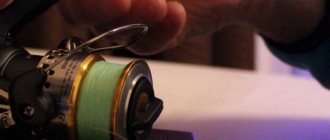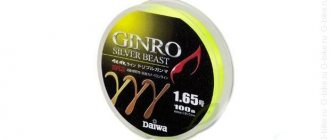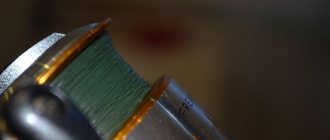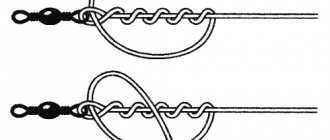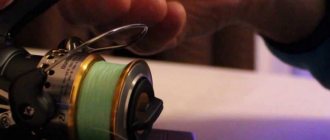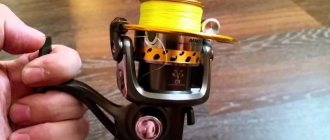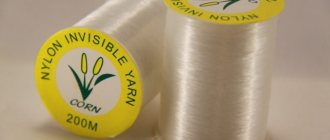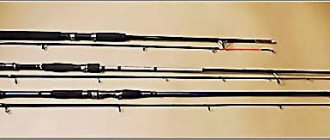Choosing a fishing line for a spinning rod, especially for a novice angler, is not so easy.
The fact is that everyone gives different advice: friends say one thing, but the store advises something completely different. The problem is also related to the fact that there is such a variety of fishing lines on the fishing equipment market that it is unlikely that you will be able to settle on any choice in one approach. Moreover, they all differ from each other in several parameters, such as color, thickness, tensile strength and material of manufacture.
Naturally, it will not be possible to choose a fishing line for all occasions, but you can come to the optimal solution.
Line color
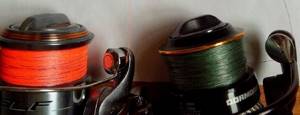
The color of the fishing line does not particularly affect the performance, although in some cases it is necessary to pay very close attention to such a nuance.
What to pay attention to:
- When fishing in clear water, you should opt for a neutral, gray or marsh shade.
- If the river has a sandy bottom, then it is better to take a transparent or sandy-colored fishing line.
- If the pond has a muddy bottom or is dominated by vegetation, green or brown fishing line should be used.
- The yellow fishing line will be visible in any body of water.
- Dark colors make it difficult to control the wiring as it is not easy to see.
- Luminescent line allows for better control of the wiring. White or pink fishing line can be easily distinguished.
Braided cord
The most popular type of fishing line among anglers. It is made by weaving together several very thin nylon threads. This production method gives the braid much greater strength, many times greater than the breaking characteristics of conventional fishing line. Other positive qualities of this type of fishing line include softness, ease of winding and minimal stretch.
Recommended reading: How to choose the right fishing line for spinning rods
The main disadvantage of braided fabric is its fragility in frosty weather. Because of this, use at subzero temperatures is not recommended. In the warm season, damage can be caused by the presence of hard or cutting objects at the bottom of the reservoir - stones or shell fragments.
It is also worth remembering that using braid with a spinning rod requires a special coating on the guide rings. Without it, the braided thread may leave marks on the inside of the rings, which will damage the fishing line.
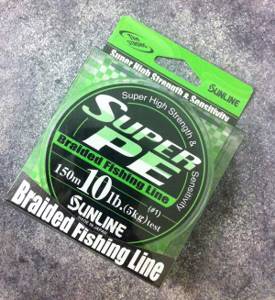
Thickness or diameter of spinning line
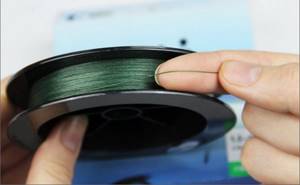
The effectiveness of spinning fishing depends on the diameter of the fishing line, if it is correctly selected for the fishing conditions. For catching small specimens, a fishing line with a diameter of 0.2-0.25 mm is sufficient. If the reservoir is clean and there is sand at the bottom, then the thickness of the fishing line can be reduced. For ultralight rods, a fishing line with a thickness of 0.12-0.14 mm is sufficient.
The thickness of the fishing line is also selected according to the weight of the baits: 25 g - 0.27 mm, 37 g - 0.35 mm and 45 g - 0.4 mm.
When choosing a fishing line, you should also take into account the test of the rod: test 1.5-12 g - line diameter 0.12-0.16 mm, test 7-30 g - line thickness 0.25-0.3 mm.
In addition to the thickness of the fishing line, there are several other factors that are also worth paying attention to. Before purchasing a product, you need to get as much information as possible about it.
The ABCs of spinning fishing. Season 1. Line used in spinning fishing
Nuances of choosing leashes for pike fishing
The basic criterion for a pike leash is that it cannot be bitten by a toothy one. Now you have a choice among ready-made ones for sale or decide on your own homemade material.
Fluorocarbon
There are no other leash options when fishing for perch and pike perch. When fishing for pike you need to be careful in using them. Often, they are used by jig fishermen. Since fishing line with a diameter of 0.35 mm is slightly better than steel, it will already be noticeable.

You have to choose between strength and camouflage. In addition, large individuals cut such leashes. So choose between 0.3 and 0.4 mm diameter.
Notes:
- Never use flucarbon on wobblers.
- A leash made of 0.25 mm fishing line is made up to one meter long for small individuals.
Special leader material
It is not difficult to make such a leash 0.3-0.4 m long. The basis of its fishing line is a braided material in the form of a tight braid, with many thin steel veins. Also covered with a protective film. It is sold either by the meter, or by 3, 5, 7 m. For its fastening, crimping tubes and fasteners with swivels are used.
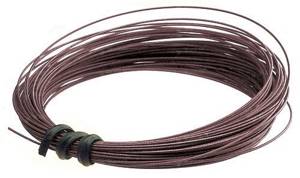
Also, ready-made leashes of the required length are already on sale. Such leashes have almost no effect on the action of the bait, do not deform and are very durable.
Notes:
- If there is strong resistance from the pike, the leash can twist into a spring and permanently receive marks from its teeth.
- When individual veins are separated from the leash, such leashes should be replaced.
Steel
The main disadvantage is minimal camouflage. Often used when quickly moving bait (jig, spoon, wobbler).
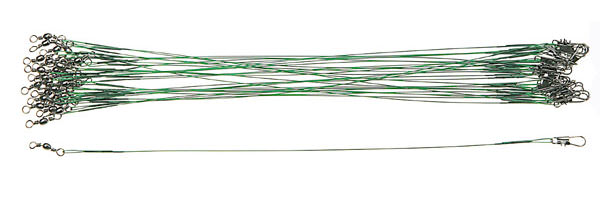
Among the advantages are the strength of the fishing line and the ability to cut through algae. Thanks to the latter, the angler does not pull out a bunch of algae along with the tackle.
You can find on sale either a special material for steel leads or one already made from it, or you can use thin guitar strings or another alternative of 0.3-0.4 mm steel wire. But still they cannot compete with special steel ones. They make leashes of 0.2-0.3 m.
Titanium
According to the characteristics, the leash is similar to the steel one, but its distinguishing feature is the lack of memory. That is, it will withstand many pike attacks and at the same time remain smooth and elastic. There is only one remark - this leash is very expensive.
Tungsten
Often, a leash is used on wobblers. Like the 2 previous materials, it is durable and visible in water. Lighter than steel. Sold ready-made.
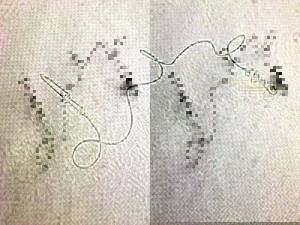
The disadvantages include the weak wear resistance of the fishing line. So, after 2-3 pike attacks, such a leash begins to twist. Requires constant inspection. If it is possible to buy a titanium one, then do not waste money on a tungsten one; in all other cases, a tungsten leash is better than other materials.
Kevlar
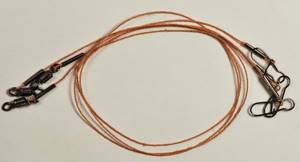
Such leashes are elastic and soft, they can be easily tied to other material, they are wear-resistant, have no memory, and are difficult for a fish to bite through. The properties are not so much inferior to steel ones, but they are little visible in the water. A Kevlar leash is made from interwoven thin flexible and durable Kevlar threads.
Monofilament line
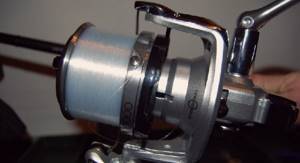
Monofilament fishing line (monofilament) is widely popular among fishermen, as it can be used to catch any type of fish. The main material for its manufacture is nylon.
When choosing, you should pay attention to:
- For breaking load. It is indicated in kilograms and is directly dependent on the diameter of the fishing line. For example, a fish weighing 1 kg can be pulled out using a monofilament line 0.12 mm thick.
- Quality. Thanks to its integrity and smoothness, the fishing line lasts a long time. Inconsistent line thickness along the entire length leads to unpredictable breaks.
- To the actual diameter. You can find manufacturers who do not accurately indicate the diameter of the product, unreasonably overestimating or underestimating it.
- For color. It is better to equip the tackle with transparent fishing line. But this does not mean that other colors may be worse: it all depends on the fishing conditions.
Advantages of monofilament fishing line:
- Does not create much resistance when placing baits.
- It is not afraid of low temperatures and does not change its structure upon contact with water and frost. The only thing is that it becomes less flexible.
- It has a certain rigidity and is suitable for making leashes.
- It has a certain stretchability, which allows you to dampen the jerks of the fish, which cannot be said about the braided line. Perfect for mastering the principles of spinning fishing.
- It is characterized by a certain invisibility in water for fish.
- Excellent resistance to various underwater surprises, such as stones, driftwood or shell rock.
- It has excellent glide, which prevents the rings from wearing out quickly.
- Monofilament fishing line has more affordable prices.
Disadvantage of monofilament line:
- If you use thin monofilament lines with a low breaking load, they will quickly break.
- If you use it in direct sunlight for a long time, it may lose some of its properties.
- Increased specific stretch has not only a positive, but also a negative effect: it poorly transfers bites to the tip of the rod. In other words, the tackle turns out to be not so sensitive.
- Has memory. The fishing line can fix its position: when it is not on the spool, it leaves it in rings, which is not always convenient during fishing.
How to choose monofilament fishing line for spinning
Main selection criteria
The choice of fishing line for a spinning rod depends on many factors, and each of them should be taken into account. Usually they start from the weight of the bait and the required casting distance; these indicators are the main ones.
Thickness
Before going to the store, you need to study the information on the form of the rod, depending on the indicators and make a choice.
| form test scores | required thickness |
| ultra light | 0.06-0.08 mm for cord and 0.14-0.18 for monofilament line |
| light | 0.1-0.12 mm cord, 0.18-0.2 mm fishing line |
| medium-light | 0.12-0.16 mm braid, 0.2-0.24 mm for fishing line |
| average | 0.14-0.18 mm cord, 0.22-0.28 mm monk |
| heavy | cord from 0.2 mm and above, and fishing line from 0.28 and above. |
The fishing line for pike fishing with a spinning rod should be as thin as possible, but with good breaking loads. This will reduce the windage of the base when casting and retrieving, but will also allow you to catch trophy specimens from the pond without any problems.
Beginners to spinning should not set the minimum permissible thickness of fishing line or cord; it is better to choose the medium option, practice all the intricacies of casting, retrieving and retrieving on it, and then gradually move on to thinner options.
Color
The fishing line for spinning rods, and the cord, come in transparent and colored ones, but which one to choose is a rather complicated question. Depending on the type of base purchased, the color is selected, taking into account the following subtleties:
- It is better to take transparent or slightly dark fishing lines for spinning for pike. This color will not be noticeable in the water; the predator will not be afraid to approach the bait and in completely transparent water in sunny weather. When choosing, you should pay attention to the markings; pike fishing lines usually have a characteristic English word on the reel and Pike packaging. This means that the product is suitable for use in pike fishing, including using a spinning rod.
- Braid for spinning for predators is chosen more from the brighter options, especially for beginners of this type of fishing. It is the light green, orange, pink cord that is ideal when placing a spinner or other bait with a spinning blank, as it shows the game perfectly even in bright sunshine. You should not be afraid of the bright color of the spinning cord; when fishing, the predator immediately pays attention to the bait, and the color of the base recedes far into the background.
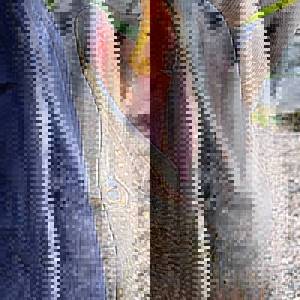
They also catch predators with neutral-colored khaki-type cords, and quite successfully. This color is usually preferred by experienced spinning fishermen.
Breaking loads
Everyone decides for themselves which fishing line to choose for a spinning rod for pike, but attention must be paid to the breaking loads of each of the options under consideration.
However, it is worth knowing some subtleties of choice and taking them into account when creating gear:
- the load declared by the manufacturer is usually true;
- each node or bend will steal from 5% to 20% of the gap indicators;
- The breaking performance of braid for spinning rods for pike is always greater with a significantly smaller thickness.
It is preferable to choose options with a minimum thickness, but with good tear properties.
The angler decides on his own which fishing line to use on a spinning rod for pike; all important characteristics are selected strictly individually.
Braided fishing line
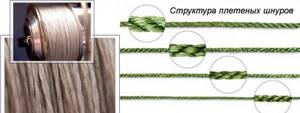
It is called "braid" or "cord". With its advent, anglers had the opportunity to choose a fishing line, depending on the nature of fishing. Braid consists of several thinner synthetic threads woven together, which have a special impregnation and sheath (sometimes). If we compare it with monofilament fishing line, it has twice the strength.
Advantages of braid:
- She has no "memory". No matter what you do with this fishing line and no matter how long it is in this state, it will always return to its original state. Although there are developments where this principle does not work so strongly.
- High strength. Despite this, it loses its characteristics with frequent contacts with underwater surprises.
- A large number of flowers. It is possible to select this element of gear for various fishing conditions. If you choose contrasting shades, you can always control the process of placing the bait.
- High sensitivity. Thanks to the low specific stretch coefficient, it instantly transfers bites to the tip of the spinning rod.
- Doesn't stretch. This property allows you to “rescue” baits that are caught on various obstacles. The hook will straighten faster than the line will break.
- Presence of impregnation. Such fishing lines are impregnated with compounds that improve its technical performance, as well as with flavors that help attract fish.
The disadvantages of braiding include:
- Its not stretchable. When catching a large specimen, the entire load is applied to the rod, which can lead to its breakage. In other words, braided line does not soften the jerk of the fish.
- Its visibility in the water. As a rule, there is no transparent braid. Any color can alert the fish.
- She is afraid of low temperatures. Temperatures of -4°C are already affecting its performance. At low temperatures, wet fishing line becomes enveloped in frost and its elasticity is lost. Several similar conditions for it, and it may be unsuitable for further use.
- Capable of absorbing moisture. This is a very bad property, which leads to the loss of its functionality, since it cannot always be dried.
- Its cost. It costs more than monofilament fishing line, but may last less.
Spinning braid
Braid has made a real revolution in spinning fishing. It provides very high sensitivity of the gear and maximum control over the bait during wiring. Its advantages are especially relevant when fishing with jigs and wobblers that require jerking. Braid is the main type of fishing line used by advanced anglers for spinning.
Advantages and disadvantages
The main advantages of braid:
- zero stretch;
- lack of memory;
- high strength with small diameter.
Unlike monofilament, braid virtually no stretch . Thanks to the zero stretch of the cord, all information from the bait is clearly transmitted through the spinning rod to the angler’s hand.
Therefore, correct wiring is easy. After a fish bites, when fishing with braided line, you can make a good hook , while due to the high extensibility of the monofilament, the force applied by the angler when sharply swinging the rod practically does not reach the hook.
Due to the lack of memory, the line does not gather in rings even after leaving the reel spool. Therefore, when fishing with it, you can make the longest casts . Also, due to the lack of memory, retrieving the bait becomes more comfortable.
With the same diameter, braid significantly exceeds monofilament in strength. Thanks to this, range of baits increases , and to perform the correct animation when fishing in the current.
The disadvantages of braiding include:
- lack of shock absorption for fish jerks;
- visibility in water;
- high price.
Due to its zero elongation, the cord does not smooth out the jerks of a trophy caught on a hook during fishing, as a result, the likelihood of derailment increases. To avoid this, you need to use a high-quality reel with a properly adjusted friction brake . It is also important to master the fishing technique.
Due to its opacity, the braid is clearly visible to fish in the water. When fishing for pike, this is generally not a big deal, but the appearance of the line can deter other fish such as perch, trout or grayling.
The price of braid is several times higher than that of monofilament. As a result, many novice fishermen refuse to buy it, but this is not worth doing. Thanks to its advantages, the cord provides the most comfortable and productive fishing , while it is much more durable than monofilament.
Which braid to choose for spinning for pike, depending on the fishing location and season
Thicker braid should be used when fishing in snags or among algae . In this case, the strength of the cord will be sufficient to free the bait after being caught. For fishing in snags, you can put hooks on them that unbend under high loads. When fishing on the open bottom, you can use lines of smaller diameters.
It is also preferable to use thinner braids when fishing in the current and at great depths - with such lines it is easiest to correctly retrieve the bait. But the breaking load of the cord must be sufficient to confidently pull out a trophy that has sat on a hook.
For fishing in the second half of spring , summer and autumn, when the fish exhibits active resistance when playing, it is preferable to use stronger cords . Thin braids are better suited for fishing in winter and early spring in clear water, when the fish are more passive.
Color
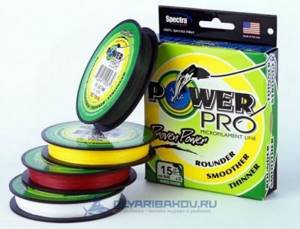
But you need to keep in mind that in water, due to its opacity, a cord of any color is clearly visible to fish. At the same time, cords of light fluorescent colors - yellow, green, orange, pink - are better visible to the angler during wiring. When using them, it is very convenient to control the movement of the bait and track the most careful touches of the fish to the nozzle. Therefore, many advanced spinning players prefer just such cords.
If the equipment needs to be as invisible as possible to the fish, you can use a long fluorocarbon leash . When using it, the number of bites increases significantly. The use of fluorocarbon is especially important when fishing with a spinning rod in winter on reservoirs that are not covered with ice, and in early spring.
The water is clear at this time, and the predator is passive and behaves cautiously. In late spring, summer and autumn, as a rule, a rig consisting of braid and a metal leash works well.
Braid breaking load
When choosing a braid, depending on the size of the expected trophies, you can focus on the following numbers:
- for catching small pike, braid with a breaking load of about 4-4.5 kg ; with such a cord you can confidently fish out trophies weighing up to 2 kg ;
- if you plan to catch a medium-sized predator , you need to use a line with a test of 7-7.5 kg - it is enough to pull out a pike weighing up to 6 kg ;
- If the catches may contain pike weighing more than 5-6 kg , braid with a breaking load of 8 to 20 kg .
The most versatile braid with a breaking load of about 7 kg . Its strength in most cases is sufficient to catch fish. Also, when fishing with it, there is always a good chance of releasing the bait from the hook.
Braid has significant advantages over monofilament , thanks to which it has become the main type of fishing line used in modern spinning rods. It can also be used for fishing with donka, girders, mugs and float live bait . Braided fishing line is more expensive than other types of fishing line, but you shouldn’t waste money on it - thanks to its outstanding working qualities , it makes fishing as comfortable and productive as possible .

Fluorocarbon line
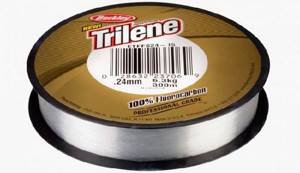
Its production is based on chemical polymers. Few people use it as a main fishing line, despite the fact that it is wear-resistant. Unfortunately, it is not as strong as monofilament and braided fishing line, and besides, its price does not allow it to be used as a main fishing line, since there are other, cheaper options. Due to the fact that it is not visible in the water, it is widely used as a leader material. Here she is simply irreplaceable.
The advantages of such a fishing line include:
- Its invisibility in water for fish. This property allows you to increase the number of bites.
- Its wear resistance. She is not afraid of shells, stones, moisture, frost, or high temperatures.
- Its strength. Thick fluorocarbon is used for pike leaders.
- Her toughness. It does not get tangled under any fishing conditions.
- Its low specific stretch coefficient makes the tackle quite sensitive.
Its disadvantages include:
- Line stiffness proves to be a problem when tying knots.
- The need to use special units, which is not always justified due to their increased size.
- Its breaking load is slightly lower compared to the same thickness of monofilament line or braid. But it may be suitable for ultralight spinning rods, where breaking load is not a major factor.
Why use fluorocarbon?
Monoline, braid or fluorocarbon
Today, the manufacturer of fishing products offers a huge selection of fishing threads, each of which can be used when fishing for predators. But when equipping your tackle with one or another type of fishing line, it is recommended to study its pros and cons.
Monofilament line
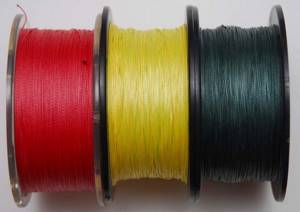
It is a common version of a solid nylon thread; it is used to catch any fish.
What to look for when choosing monofilament:
- The breaking load is calculated in kilograms and depends on the thickness of the product (for example, prey of 1 kg can be caught on a 0.12 mm fishing line).
- Strength. The product has a special coating that provides a sliding effect and sufficient wear resistance.
- The dimensions indicated on the packaging must correspond to the actual dimensions of the fishing line. There are cases when unscrupulous manufacturers slightly exaggerate the declared dimensions (diameter).
- color , but you can also purchase colored thread for experiments.
The positive qualities of monofilament include:
- It does not provide unnecessary resistance in the water , which allows you to freely move the bait near the bottom.
- It is not afraid of low temperatures ; when exposed to frost, it retains its structure.
- It has sufficient rigidity , it is good to use as a leash, and does not get tangled.
- It has the ability to absorb sudden jerks of prey ; when stretched, the load falls not only on the fishing line, but also on the spinning rod.
- Hides mistakes in hooking by novice fishermen.
- The fishing line is practically invisible in the water to the eyes of a predator.
- When fishing in hard-to-reach places, it retains its structure, does not fray and fray so much (on stones, snags, etc.).
- Thanks to a special coating , the thread easily slides in the rings, increasing the casting distance, regardless of the weight of the bait.
- Belongs to the category of budget products.
Negative points include:
- The smaller the diameter, the weaker the breaking load.
- When interacting with sunlight, it loses its properties and wears out quickly.
- Good stretchability of the thread has the opposite effect: it does not sense weak bites and forces the fisherman to drag the prey ashore for a long time.
- Has memory.
Braided cord

Braid is another type of fishing thread, but with greater strength, consisting of 4 - 8 synthetic fibers. The product is woven using the latest technology, the threads are impregnated with a special lubricant.
The positive qualities of braided cord include:
- It has no “memory” ; the product retains its original shape after being in a twisted position for a long time, after tying knots and other actions.
- Has a high degree of wear and strength.
- Has a low elongation index.
- A huge range of colors; to visualize what is happening underwater, it is recommended to choose a product in a contrasting shade.
- Due to the lack of elongation , the cord exhibits good sensitivity to bites, even the smallest ones.
- Thanks to the presence of various flavors in the impregnation of the product, it becomes possible to attract fish from all over the reservoir.
Negative points include:
- Lack of stretchability has a bad effect on the integrity of the spinning rod.
- Cords are available in various colors , but there are no transparent products; the predator sees it well and shows increased caution.
- It is afraid of frost , even at a temperature of -4 degrees the cord becomes covered with frost, and the lubricant layer disappears.
- To use it, you need to equip the tackle with a reel with an aluminum spool; plastic options will quickly become unusable and the cord will cut through them.
- Expensiveness of the product.
Fluorocarbon line
The new generation thread, made from fluorocarbon polymer, has won the trust of spinning players for its invisibility in water due to the available light coefficient, which is as close as possible to the water.
The positive qualities of fluorocarbon include:
- High level of wear resistance.
- Invisibility in water.
- Does not lose its qualities even with prolonged use under ultraviolet rays.
Negative points include:
- The high cost of the material.
- Low breaking load , which does not allow the product to be used as a main fishing line; this is only possible for light class rods.
- Requires the ability to tie special knots for fluorocarbon leaders.
Leash and main line
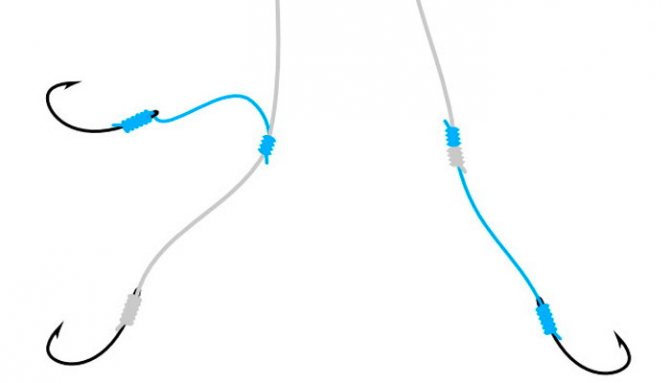
Almost all rigs require a leash that performs several functions. If it is made of fluorocarbon, then it is not noticeable, which does not alarm the fish. In addition, in case of snags, the main line does not break, and replacing the leash takes a couple of minutes.
The leash is attached in various ways: either using knots, or using various latches or carabiners. Which simplifies the replacement process.
As a rule, the leash always has a lower breaking load compared to the main line, by about 10-20%. As a rule, fluorocarbon fishing line with a thickness of 0.1-0.15 mm or more is used as leashes if large individuals are biting.
Leashes can have the following characteristics:
- Pop-up. They are made of wicker and are designed for muddy or unclean bottoms.
- Rigid and durable for difficult water bodies with a lot of vegetation.
- Combined. Fluorocarbon with thread is suitable for very difficult fishing conditions.
Types of fishing line
Modern industry, focused on the production of goods for amateur fishermen, offers more and more new options for fishing lines with different characteristics. They differ markedly in their source material and, therefore, in their performance characteristics.
At the moment, the following are most often used in spinning fishing as the main line :
- Monofilament. Monofilament fishing line is made primarily from nylon and has been known to anglers for centuries. It demonstrates quite decent tensile strength, which is directly dependent on the diameter.
- Network. A fishing line woven from several strands with different characteristics is often used as the basis of gear when catching trophy specimens. It is especially good in conditions where the risk of snagging is increased.
- Fluorocarbon. A relatively new, but rapidly gaining popularity option. It is not particularly durable, but has another “trick” - maximum mimicry in water.
Unfortunately, there is no universal option, so let’s try to understand the advantages and disadvantages of different types of fishing lines in more detail.
Monofilament
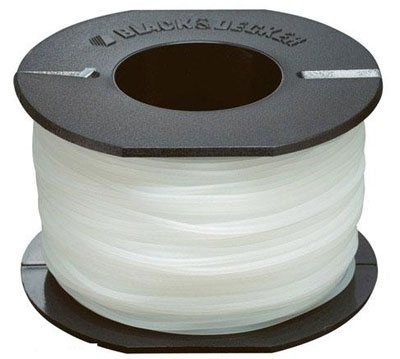
Monofilament fishing line is an honored veteran of fishing: it was born with the birth of the first synthetic polymers. When choosing a monofilament fishing line, you should pay special attention to the manufacturer: it is not too expensive, so it is better to give preference to proven brands.
The most pleasant features of spinning fishing
include:
- Favorable “behavior” during wiring. The monofilament reacts well to the actions of the fisherman, allowing you to conduct the wiring as if it were in a textbook.
- Extensibility. Extensibility can be seen as a positive characteristic: the core absorbs shock, dampening the movements of the prey and reducing the load on the rod, which minimizes the risk of its breakage.
- Resistance to low temperatures. In cold weather, monofilament becomes stiffer, but as the temperature rises, it quickly restores its original characteristics.
- Relative invisibility. With the right choice of color, monofilament is practically invisible in water, especially transparent or with light natural shades.
- Availability. Monofilament fishing line is the most affordable option among all existing ones.
Negative characteristics look like this:
- UV instability. With frequent use in the open sun, monofilament becomes more rigid and inelastic.
- Extensibility. Excessive extensibility also has a negative side: it prevents a clear transmission of the bite to the rod, and also helps to loosen the knots on the rig (which is why it must be wetted when tying).
- Memory effect. The fishing line “remembers” the shape it has been in for a long time. This means that it comes off the spool in coils, which is not very comfortable.
Network
Braided fishing line is several interwoven strands made from artificial polymer materials. Sometimes these veins are impregnated with all sorts of compounds (including flavorings), and are also enclosed in personal shells.
Among the advantages of braids are:
- High strength. Braid is twice as strong as monofilament of the same diameter (with proper quality, of course).
- Wide range of colors. Technologies allow you to give the braid any color and complete opacity.
- No memory effect. Braided fishing line lays flat even from the spool: it is not subject to deformation.
- Fine transmission. Thanks to its minimal stretch, braid immediately transmits the bite to the rod - everything depends solely on the angler’s reaction.
- UV resistance. When used for a long time in the open sun, the braid does not lose its properties.
The obvious disadvantages of braiding are the consequences of its advantages:
- Moisture permeability. Water can stagnate in the weaving, which leads to deterioration in performance. Drying the cord from the inside is problematic.
- Inextensibility. This characteristic has a positive effect on the sensitivity of the equipment, but a negative effect on its strength. When fishing for a powerful specimen, you can break the rod: the cord does not cushion or dampen movement.
- Visibility. When catching a passive, cautious predator, it is better not to use braided line: it is noticeable in the water from afar and is not found in a transparent version.
- Sensitivity to cold. At low temperatures (even not in frost), the braid becomes rigid and loses some of its positive properties, sometimes irrevocably.
- High price. Braid from the same manufacturer will definitely cost more than monofilament.
Fluorocarbon
Fluorocarbon line is a relatively new phenomenon in the fishing tackle market. The scope of its application is quite limited (it is used mainly for creating leashes), but ultralight lovers sometimes use it as their main one.
The positive qualities of fluorocarbon are as follows:
- Stealth. Spinning fishermen often choose fluorocarbon line to catch a passive predator - due to its low visibility, it does not alert the fish.
- Rigidity. Sufficient rigidity contributes to good bite transmission to the rod.
- Durability. Fluorocarbon fishing line lasts a long time: it is not subject to rapid wear even in conditions of fishing on stones or shell rock.
- Heat resistance. This fishing line does not deteriorate when exposed to direct sunlight and low temperatures.
- Minimal memory. Fluorocarbon does not “remember” its shape well, so it comes off the spool smoothly, not in turns.
negative qualities , but they exist:
- Rigidity. Excessive rigidity creates problems during rigging: the knots turn out to be quite rough.
- Low tensile strength. Everything in the world is relative: high-quality fluorocarbon cannot be called fragile, but it is noticeably inferior to monofilament, and even more so, to braided material.
- High price. Branded fluorocarbon fishing line is expensive, so its use as the main line is not financially justified.
Choosing a fishing line for pike
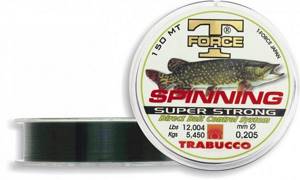
It is advisable to choose a cord with a diameter of 0.16-0.2 mm. For a beginner, a cheaper option will be better, since after active and frequent casting, especially unqualified ones, the fishing line will quickly fail. As for color, the best options would be green or brown. When jigging and twitching, the best results are obtained when using braid. When casting long distances it is also unrivaled.
As for monofilament fishing line, it is not replaceable when fishing with oscillating or rotating spoons. In this case, a fishing line with a thickness of 0.28-0.35 mm is preferable. Many manufacturers indicate on the packaging that this is a line for pike fishing. For example, DAIWA Samurai-Pike 3 (Pike-pike) line.
How to choose winter fishing line according to parameters
Depending on the material of the fishing line, it is characterized by the features of its structure. Differences in structures have a unique impact on fishing, which is something you should pay attention to when choosing a thread. Of course, it is important to use a reliable fishing line for a winter fishing rod, but it is also necessary to navigate the characteristics that can improve the comfort of fishing. Our further in-depth review will cover the main characteristics of ice fishing cords.
Working diameter
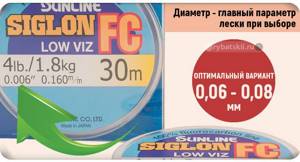
In winter, an important condition is the diameter of the fishing line
The optimal working diameter is one of the important requirements for the formation of winter equipment for any gear. In winter fishing conditions, anglers use very thin fishing lines. Delicate equipment, assembled on cords with diameters of 0.06 - 0.08 mm. The thickness of the thread is selected in accordance with the structural features of the reservoir being fished, as well as the size of the fish planned as a trophy. The rationale for using small diameters is due to:
- water transparency, which is higher in winter than in the summer fishing season, which in turn alarms the fish and requires the use of as many invisible fishing lines as possible;
- fish in cold water become more picky in their appetites and can savor the bait for a long time, studying its taste. Any suspicious element of equipment easily becomes an obstacle to increasing the bite;
- In addition, winter fishing strategies are distinguished by the use of small baits, which justifies the sophistication of the line, and thereby the natural behavior of the bait, which is especially true for animal baits and small-sized live bait.
Expert advice
Forester Seva
Fisherman expert
Ask a Question
Rigging should be delicate in winter, but also consider your skill level when choosing a diameter. Amateur fishermen are not recommended to go below 0.8 mm even for catching small perch or roach. Diameters such as 0.06 or even 0.04 are highly specialized monofilaments for athletes who know how to handle them. It makes no sense for an amateur to take such thin fishing lines, since in the end this will not affect the result, but can only cause trouble in the form of tangling or breaks.
Question to the expert
Can you use the same line in winter for two or three seasons in a row?
It is recommended to change thin winter fishing lines every season. Even if monofilament is properly stored between seasons, it will still lose its performance characteristics and be noticeably weaker.
What is the best way to store monofilament in winter?
There is no need to store the fishing line in a warm room, but it is better to keep it on the balcony, for example, or even in the garage. In the cold, monofilament does not lose its characteristics so quickly.
Strength
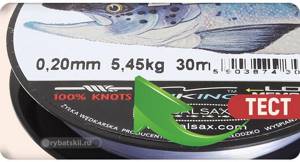
See the packaging for breaking load
A strong fishing line for winter fishing will help you cope with large trophies. It is worth noting that from different manufacturers the tensile strength of threads may differ in their digital indicators. When purchasing cords, pay attention to this factor by looking for information on product packaging. It would also be useful to conduct practical tests of strength by testing the threads with a real load and determining the strength limits. An unscrupulous manufacturer can easily inflate the indicator in pursuit of sales, which in real fishing conditions will play a fatal role and result in the loss of a trophy.
Specific stretch coefficient
The peculiarities of winter fishing suggest more frequent practical use of elastic threads with increased stretching parameters of the material structure. Most fishing methods, be it jig fishing or ice fishing, force you to remove the rig, and with it the trophy, with your bare hands. In such cases, the load is concentrated on the main line. Then we state the following fact - that the higher the shock-absorbing qualities of the thread used in the gear, the less likely the equipment will break and the catch will be lost.
Memory
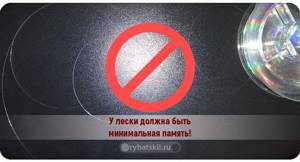
Line twisting demonstration
The fishing line installed on a winter fishing rod must have minimal memory. This criterion is important for the comfort of fishing, and a straight line without the so-called pig tail effect is not so alarming to fish that are shy in winter.
Miniature gear for ice fishing is characterized by the use of small-volume reels and reels. When assembling gear, fishing lines are subject to more severe structural deformations per unit of length, which, when in working condition, fishing line with high memory parameters seriously complicates fishing. The lack of memory will allow you to quickly send the bait to the water horizons required by fishing conditions, more accurately tracking the state of the installation, its animation and the moment of the bite itself.
Abrasion resistance
When fishing on shell rocks and pebble bottoms, the rig is subject to increased abrasion. Threads that are not resistant to abrasive quickly fail, losing the originally stated parameters of the breaking loads of the material. This is especially true for winter spinning fishing in areas of open water, where braids are the priority threads.
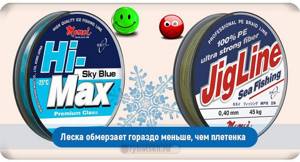
The advantage of monofilament over cord is that it freezes less
To use a braided cord at low positive and completely negative temperatures, lubricating the cord with silicone prevents freezing.
When fishing from ice, it is worth noting that most specific winter monofilament lines cope with the influence on the structure of ice crumbs and are little susceptible to freezing, allowing you to fish reliably and without fear of losing the strength of the equipment.

